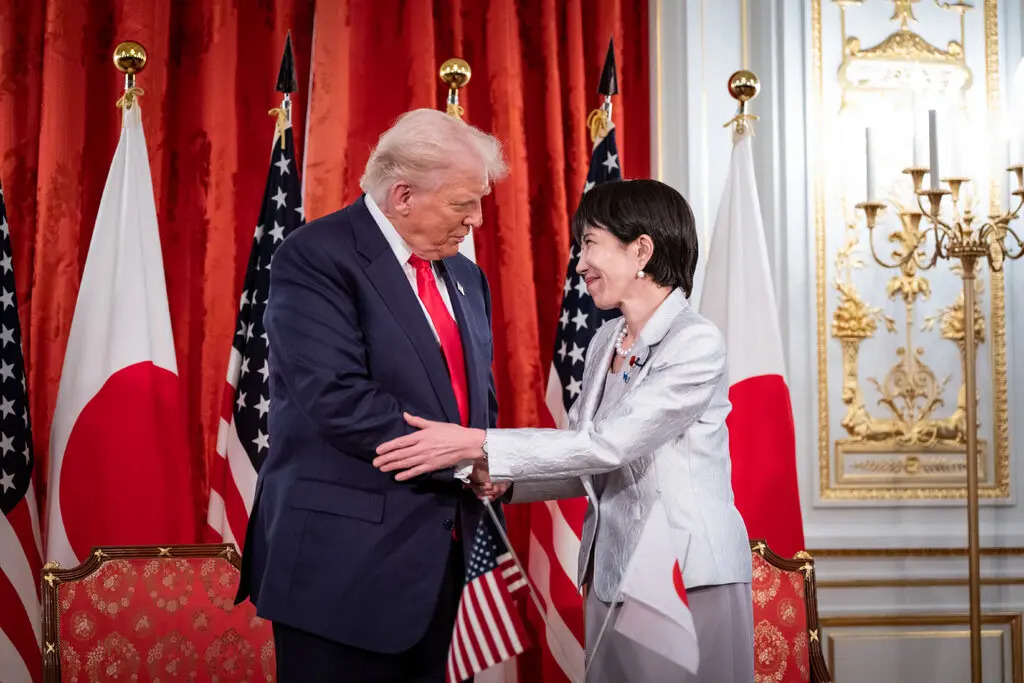A stronger alliance between the U.S. and Japan poses significant challenges for China, but it’s important to recognize the internal and external constraints on Prime Minister Sanae Takaichi’s foreign policy. Actively identifying new areas of growth and nurturing the internal momentum of the relationship is essential.

Prime Minister Sanae Takaichi of Japan welcomes U.S. President Donald Trump at Akasaka Palace in Tokyo, Japan, Oct. 28, 2025.
Sanae Takaichi took office in October 2025 as prime minister of Japan, the most important U.S. ally in the Asia-Pacific region. Less than a week later, U.S. President Donald Trump visited Japan — his first visit since returning to the White House for a second term.
The Trump visit was highly anticipated. Three days after taking office, Takaichi had announced that Japan’s defense spending would increase to 2 percent of GDP in fiscal year 2025, two years ahead of schedule. At the same time, three important U.S. security policy documents, including the National Security Strategy, were set to be revised. During the summit, Trump praised the increase, along with Japan’s purchases of U.S. military equipment. He also joined Takaichi aboard the presidential helicopter to visit the aircraft carrier USS George Washington, which was docked in Yokosuka. There he met with U.S. sailors to demonstrate the strength of the U.S.-Japan alliance.
Takaichi represents the hard-line conservative faction of Japan’s Liberal Democratic Party. Her past positions on China have raised concerns about the potential negative impact she could have on China-Japan relations. During Trump’s visit, Takaichi called for start of a “golden era” of relations with the United States, a statement that only reinforced the questions.
The future direction of Takaichi’s diplomacy will depend on the dynamics of domestic politics and the sustainability of her cabinet. Takaichi is Japan’s first female prime minister, and in structural terms she represents the beginning of a genuine multiparty era in the country. The LDP, formed in 1955, dominated Japan’s political landscape throughout most of the Cold War. In the 1990s, party politics in Japan went through a period of turmoil, and by the turn of the century the LDP had formed a coalition government with what is now called the Komeito party, creating a political structure that has endured for more than two decades and brought relative stability and predictability. However, the cabinet of Shigeru Ishiba, who became prime minister in October 2024, suffered electoral defeats in both the House of Representatives and House of Councillors, causing the ruling coalition to lose its majority for the first time since the LDP’s founding — a development that marked the beginning of Japan’s transition toward multiparty politics.
Following Takaichi’s election as LDP president, Komeito withdrew from the coalition, ending a 26-year alliance. This effectively dismantled the LDP’s long-standing dominance and officially ushered in a new era of multiparty competition in Japanese politics.
The sustainability of the Takaichi cabinet depends not only on maintaining unity within the LDP but also, to a large extent, on the speed and manner in which the ruling and opposition parties can reach policy consensus. Under a multiparty political structure, the Takaichi cabinet must adopt a “moderate conservative” approach to achieve stable governance.
While a multiparty system reduces the predictability of Japanese politics, it also reflects the growing diversity of interests in Japanese society. In foreign relations, an overly hard-line conservative stance by Takaichi could divert the ruling and opposition parties’ attention from substantive policy negotiations, or even trigger divisions within the LDP itself, thus hindering long-term governance. This is why the prime minister tries to avoid discussing politically sensitive issues such as the Yasukuni Shrine.
In addition, the trajectory of U.S.-China relations and the direction of Trump’s economic policies toward Japan will be the most significant external factors shaping Takaichi’s China policy. Unlike the Biden administration, Trump places less emphasis on values and ideology in managing alliances. Rather, he adheres to a more pragmatic principle.
Since beginning his second term, Trump has repeatedly expressed a willingness to meet with Chinese leaders. Despite his frequent threats of imposing extreme tariffs on China, Beijing has firmly safeguarded its own interests while remaining open to negotiations. This has resulted in significant achievements in five rounds of high-level trade talks.
Within Japan, there is considerable dissatisfaction over Trump’s compromises in trade negotiations with China, even as he has maintained a harsh stance toward allies. In 1972, President Richard Nixon visited China without informing Japan in advance — a visit that in Japan was known as the “Nixon shock.” Even today, Tokyo remains deeply wary of potentially aggressive diplomatic moves by Washington toward Beijing, and Takaichi is cautious of another potential shock.
Meanwhile, the tariff agreement reached between the U.S. and Japan in July will pose a challenge to Takaichi’s diplomacy, particularly regarding how to advance Japan’s $550 billion commitment of investment in the United States. During Trump’s recent visit to Japan, the two sides signed memorandums of understanding covering various sectors, including electricity, although the designation of specific projects has not yet begun. The $550 billion figure -— equivalent to 40 percent of Japan’s foreign exchange reserves — means that how these funds are deployed will directly affect Japan’s economic development potential and could become a crucial element in future power dynamics within the U.S.-Japan alliance. Given that China is Japan’s most important economic partner, it is unrealistic for Tokyo to fully align its economic policies with Washington.
While Prime Minister Takaichi’s administration and the strengthening of the U.S.-Japan alliance pose significant challenges to China-Japan relations, it is also important to recognize the internal and external constraints on Takaichi’s foreign policy. The relationship between China and Japan is like rowing against a current: If the boat does not move forward, it will inevitably fall behind. Actively identifying new areas of growth and nurturing the internal momentum of China-Japan relations will therefore be essential.
